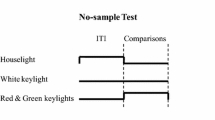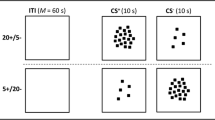Abstract
A hypothetical neural network is presented to account for errors made by food-deprived albino-rats in a bar-pressing situation (Carlton, 1964). The rats were required to press alternately on two bars in order to activate a device that releases milk to them. When-ever an animal pressed consecutively on the same bar, no milk was released and the animal was scored as having committed an error. In the first part of the paper, a time-independent neural network, part of which is equivalent to the psychophysical discrimination network of H. D. Landahl (1938), is used to interpret the effects on the animals’ performances of the drugs amphetamine, scopolamine and atropine. Suggestions for further experiments are made on the basis of the initial form to the model. In the second part of the paper, certain parameters of the initial form of the model are assumed to be time-dependent and a further generalization occurs through the introduction of the interresponse time distribution. It is shown that, under specified conditions, the second form of the model reduces to the first. The time-dependent form of the model allows certain features to be discussed that could not be discussed in the time-independent form [e.g. P. Dew’s (1961) notion of a possible mode of action for a variety of the behavioral effects of amphetamine]. Furthermore, experiments of an essentially different type from those discussed in the first part can be proposed to aid in the development of a theory for this kind of behavioral situation.
Similar content being viewed by others
References
Carlton, P. L. 1963. “Cholinergic Mechanisms in the Control of Behavior by the Brain”.Psychol. Rev.,70, 19–40.
Cutting, W. C. 1962.Handbook of Pharmacology. New York: Appelton-Century-Crofts.
Dews, P. and W. Morse 1961. “Behavioral Pharmacology.”Ann. Rev. Pharmacol.,1, 145–174.
Handbook of Physics and Chemistry. 1956. Cleveland, Ohio: Chemical Rubber Publishing Company.
Landahl, H. D. 1938. “Contributions to Mathematical Biophysics of Psychophysical Discrimination.”Psychometrika,3, 107–125.
Mandler, George. 1962. “Emotion,” InNew Directions in Psychology R. Brownet al., Eds. New York: Holt, Rinehart and Winston.
McGill, W. 1963. “Stochastic Latency Mechanisms.” InHandbook of Mathematical Psychology. Vol. I., R. D. Luceet al., Eds. New York: John Wiley and Sons, Inc.
Rashevsky, N. 1959.Mathematical Biology of Social Behavior. Chicago: University of Chicago Press.
— 1960.Mathematical Biophysics. Vol. II. New York: Dover Publications.
— 1964.Some Medical Aspects on Mathematical Biology. Springfield, Illinois: Charles C. Thomas, Publisher.
— 1966. “A Mathematical Model of Some Mental Disturbances.”Med. Opin. and Rev.,1, 65–72.
Riggs, D. 1963.The Mathematical Approach to Physiological Problems. Baltimore: The Williams and Wilkins Company.
Sidman, M. 1956. “Drug-Behavior Interaction.”Ann. of the N.Y. Acad. of Sci.,65, 282–302.
Author information
Authors and Affiliations
Rights and permissions
About this article
Cite this article
Reilly, K.D. Models for scopolamine, atropine and amphetamine effects on an alternate bar pressing paradigm. Bulletin of Mathematical Biophysics 29, 767–779 (1967). https://doi.org/10.1007/BF02476927
Received:
Issue Date:
DOI: https://doi.org/10.1007/BF02476927




